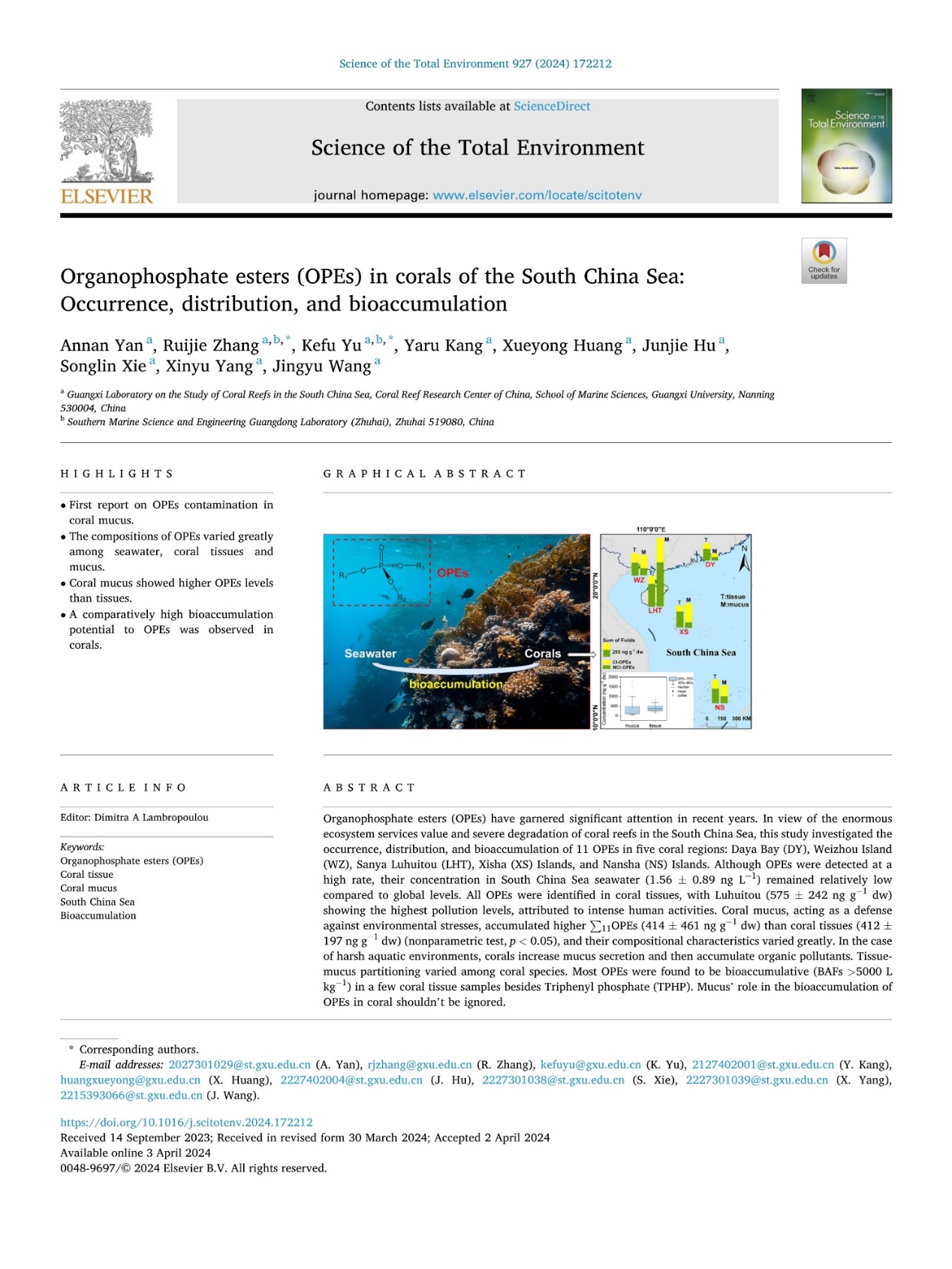Yan Annan, a graduate student, presented the results of Organophosphate esters (OPEs) bioaccumulation characteristics in coral reef regions of the South China Sea at STOTEN
Recently, under the guidance of Associate Professor Zhang Ruijie, Yan Annan published a research paper entitled "Organophosphate esters (OPEs) in corals of the South China Sea: Occurrence, distribution, and bioaccumulation" in Science of the Total Environment (IF=9.8)
Organophosphate esters (OPEs) are a class of synthetic derivatives of phosphate esters, as flame retardants, plasticizers and other functional additives. They are mainly added to the material by physical means. It is easy to release into the surrounding environment through volatilization, wear and other forms, so the presence of OPEs can be detected in almost all kinds of environment media. In addition, OPEs have been confirmed to have carcinogenicity, neurotoxicity and other biological toxicity. OPEs have a strong long-distance transmission and bioaccumulation ability, so they can cause many ecological environmental problems, which has aroused the great attention of scientific researchers.
The ocean is regarded as the ultimate destination (sink) of land-based OPEs pollution, so the distribution, sources and ecological effects of OPEs in the ocean have also aroused attention. With rich biodiversity and great productivity, coral reefs are one of the major marine ecosystems. At the same time, it is very fragile and easily affected by the surrounding aquatic environment. Coral reefs in the South China Sea have experienced severe degradation over the past 50 years. In recent years, PCBs, OCPs, PAHs and other persistent organic pollutants have been detected in coral and found to be toxic to coral. Coral mucus acts as a barrier between coral tissue and seawater, resisting various environmental stresses, and is essential for coral growth and development. At present, there is only one report published by our school on OPEs pollution in coral reef area of Weizhou Island. However, there is still no research on OPEs pollution in coral reef area of large spatial scale in the South China Sea, especially on OPEs in coral mucus. Therefore, we selected Weizhou Island, Daya Bay, Luhuitui, Xisha Islands and Nansha Islands as the study area to investigate the concentration and distribution of 11 common OPEs in seawater, coral tissue and mucus in the South China Sea, and discussed the bioaccumulation ability and characteristics of the target compounds in the coral reef area.
The findings are as follows: (1) OPEs exist widely in the seawater of the South China Sea, but its concentration is at a low level, indicating that the pollution of OPEs in the South China Sea is relatively light. The concentration of OPEs in seawater decreased significantly from near shore to offshore regions, which should be the result of seawater dilution, compound degradation, ocean current and other factors. (2) All 11 species of OPEs were detected in coral tissues, and the concentration level and composition of OPEs in corals were similar to those in the near and offshore seas. Luhuitou is the most polluted area, which is related to its huge tourist flow and strong human activities. Among the OPEs, tris (2-butoxyethyl) phosphate (TBOEP) occupies the dominant position. (3) Waterpik and tweezers are the two methods for extracting coral tissues. However, both the quality of extracted tissues and the concentration of OPEs in tissues are significantly higher in the former than that of tweezers. It also proves that the OPEs enrichment ability of zooxantheles is stronger than that of coral polyps. (4) The concentration of OPEs in mucus was significantly higher than that in tissue, and its composition characteristics were very different. In the case of a poor aquatic environment, corals will secrete more mucus to enrich pollutants to protect corals. (5) Most OPEs are bioaccumulated or potentially bioaccumulated in corals, in which coral mucus plays an important role. The concentration of OPEs in tissues of offshore corals was significantly higher than that of nearshore corals, which may be related to the low secretion of mucus.
This study fills the gap in the research of OPEs in seawater, coral tissues, and especially coral mucus in the coral reef regions of the South China Sea at a large spatial scale. It deepens the understanding of the concentration level, composition and enrichment characteristics of OPEs in the seawater and coral reef of the South China Sea. Besides, it provides scientific basic data support for the conservation of coral reef area resources.
The detailed information of the paper is as follows:
Yan Annan, Zhang Ruijie, Yu Kefu, Kang Yaru, Huang Xueyong, Hu Junjie, Xie Songlin, Yang Xinyu, Wang Jingyu. (2024). Organophosphate esters (OPEs) in corals of the South China Sea: Occurrence, distribution, and bioaccumulation. Science of The Total Environment 927, 172212.https://doi.org/10.1016/j.scitotenv.2024.172212.
